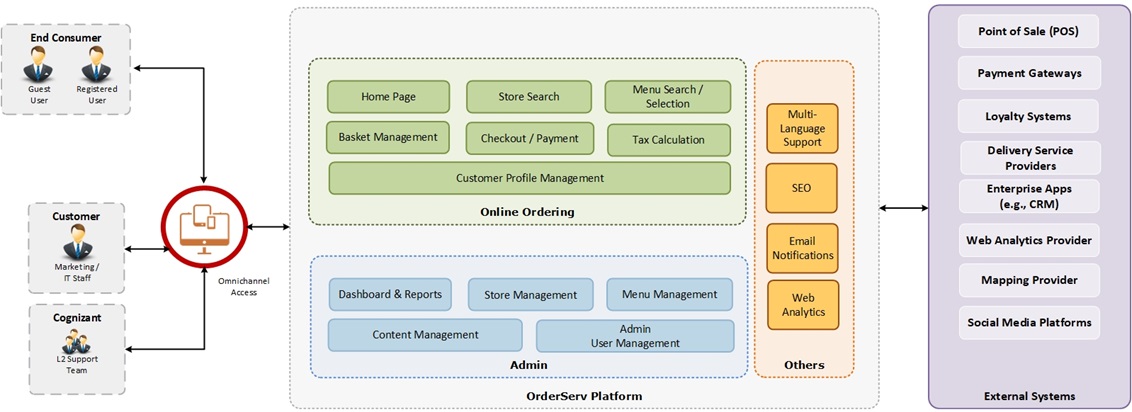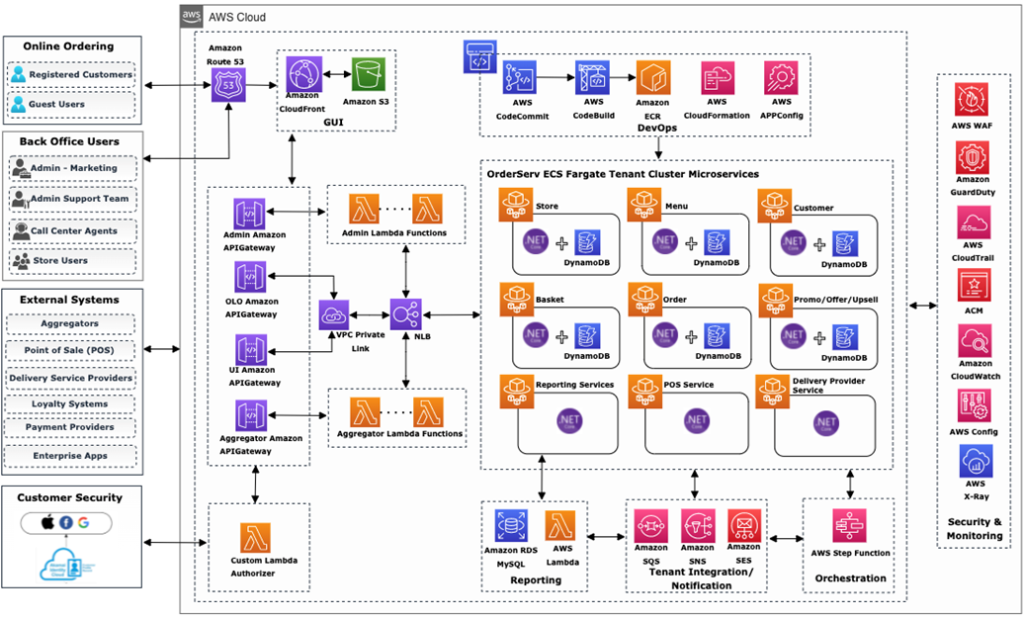AWS Partner Network (APN) Blog
Reimagining Digital Food Ordering with the Cognizant OrderServ 2.0 Platform
By Tapas Khan, Principal Architect – Cognizant
By Suddhasattwa Mukherjee, Sr. Architect – Cognizant
By Raja GT, Sr. Partner Solutions Architect – AWS
 |
| Cognizant |
 |
Digital food ordering is one of the fastest-growing industries in the world today. It frequently redefines its business model and strategy in response to consumer demands and market competition. The industry’s transition also embraces technology in order to meet customer needs and open up new commercial opportunities.
Nowadays, customers expect the flexibility to order food through multiple channels. Whether in store, at home, or on the go, customers want to order their favorite meals and get it delivered quickly. Moreover, they expect restaurants to remember their favorite items and suggest new and relevant offers based on order history and preferences.
Cognizant’s OrderServ 2.0 platform is an omnichannel digital ordering platform designed for the restaurant and food services industries. Cognizant re-architected the existing monolith OrderServ 1.0 platform to meet the business objectives and increasing customer demands.
The new Cognizant OrderServ 2.0 platform offers customers in the food service sector an omnichannel experience that guarantees quick service and a positive customer experience. It has built-in connectors for seamless integration with restaurant point-of-sale (POS) systems, master data management, payments services, loyalty programs, and other business applications.
OrderServ 2.0 is offered as a software-as-a-service (SaaS) platform hosted on Amazon Web Services (AWS). However, this does not bind organizations to the platform; you can tailor it to every market or to each unique markets. The platform is built as a headless architecture, allowing you to bring your unique digital assets while providing plug-and-play security modules to satisfy your organization’s security needs. As a result, customers can concentrate on company strategy while the platform handles the rest.
In this post, we will explain how the Cognizant OrderServ 2.0 platform used AWS serverless architecture in the end-to-end solution to cut total cost of ownership (TCO) while adhering to AWS best practices.
Cognizant is an AWS Premier Tier Services Partner with 12 AWS Competencies. Cognizant is also a member of the AWS Managed Service Provider (MSP) and AWS Well-Architected Partner Programs.
What is Bundled in OrderServ 2.0?
The OrderServ 2.0 platform includes the following key components: ordering engine, connectors, admin application, call center application, and web interfaces (web application and mobile application). Each component runs independently and has the flexibility to be customized.
The food ordering platform presently supports the following channels: aggregators, kiosk, web, mobile, and call center.
Figure 1 – OrderServ functional architecture.
Architecture Overview
The core component of the OrderServ 2.0 platform is the ordering engine, which is built on loosely-coupled microservices that adhere to an even-driven architecture pattern. The platform is designed with a headless architecture, and the version-controlled API uses Amazon API Gateway for request and response authentication, validation, and transformation.
The underlying microservices are Docker containers that run on serverless AWS Fargate compute. The platform scales effortlessly to handle more than a million transactions per month by leveraging the capability of Amazon DynamoDB for online transactions and Amazon Relational Database Service (Amazon RDS) for lightweight reporting transactions.
The computing microservices are constrained by their own responsibility for data maintenance and security, and events are published in Amazon Simple Queue Service (SQS) and Amazon Simple Notification Service (SNS). The microservices work in tandem with the events generated in message queues and communicate with one another via the service mesh AWS App Mesh.
The design’s various components are well orchestrated utilizing AWS Step Functions. The computation scalability and cost are addressed by constructing short-lived functionalities using AWS Lambda.
Figure 2 – OrderServ 2.0 platform architecture.
Continuous Delivery and Integration
OrderServ 2.0 platform is completely automated. The application software is continuously delivered and integrated using AWS CodeCommit, AWS CodeBuild, and AWS CodePipeline. The build process generates Docker containers with commit hash codes and deploys them to an Amazon Elastic Container Service (Amazon ECS) cluster.
The rolling update strategy is utilized to prevent downtime during deployment. The infrastructure is built using AWS CloudFormation templates and deployed using the AWS CloudFormation stack.
Monitor Workloads
OrderServ 2.0 has predefined metrics and custom metrics configured in AWS CloudWatch. The metrics create alarms for the operations team whenever a threshold is exceeded, which can be API timeout, Lambda throttling, database scaling, or custom metrics such as order failures, external system connectivity lag, and so on.
Due to the loosely-coupled microservices services, it’s critical to implement end-to-end tracing of requests for platform debugging. AWS X-Ray assists in the analysis and debugging of the OrderServ distributed application.
Perform at Scale
The OrderServ 2.0 platform is built on an event-driven design. The microservices, which include Lambda functions and ECS containers, communicate with one another using Amazon SQS and SNS. The serverless and fully-managed message queue and topic services improve overall reliability while also scaling to meet demand.
The transactions are linked to data stores such as Amazon Simple Storage Service (Amazon S3) for precomputed and reusable object storage, Amazon DynamoDB for key value object data partitioned by tenant, and Amazon RDS for transactional data. While each of these components scales independently to meet peak demand, the user experience is enhanced further by Amazon CloudFront‘s low latency content network.
The application data is cached at each layer, including the content network, Amazon API Gateway, Lambda extensions, ECS, and data stores, allowing for sub-second responses.
Securing Workloads
OrderServ 2.0 is built with security in mind, and the entire platform is hosted on AWS in a secure virtual private cloud (VPC). The ingress rules only allows traffic from Amazon API Gateway and routes the request to the Elastic Load Balancer which, in turn, distributes the load among containers. Any other external inbound request is denied, and the egress rules permit content download from the approved IP list.
The platform also adheres to the principle of least privilege with AWS Identity and Access Management (IAM) users, roles, groups, and policies, as well as AWS security groups and Network Access Control Lists (ACLs) to protect Amazon VPCs.
The configuration of AWS resources is assessed and audited by AWS Config and any malicious activity is constantly monitored by Amazon GuardDuty. Custom Lambda authorizers protect application security by integrating with Amazon Cognito or other external security solution. The data at rest is encrypted with AWS Key Management Service (AWS KMS) and can be integrated with any other third-party KMS solution.
Anticipate Failure
OrderServ 2.0 is designed for failure. It leverages multi-AWS Availability Zone (AZ) deployment both for Amazon ECS on AWS Fargate and Amazon RDS for MySQL. Application Load Balancing is used to receive inbound traffic and route it to ECS across various AZs.
To provide business continuity in the unlikely event that an AWS region fails, the entire infrastructure has been replicated in another region using Amazon S3 cross-region replication, DynamoDB global table, and Amazon RDS for MySQL read replica.
Key Benefits
The Cognizant OrderServ 2.0 serverless platform is built on cloud-native principles which perform at scale and provides a cost-effective, automated solution. It features built-in security and access controls that may be customized to fit organizational needs.
Continuous delivery, combined with loosely coupled components in the architecture, accelerates time to market.
The OrderServ 2.0 architecture provides the following advantages:
- Reduction in AWS infrastructure expenses, even with order surges.
- Improved scalability and the ability to handle surges in orders with ease.
- Improved availability with no downtime or latency issues.
- Faster time-to-market updates.
- Better observability and monitoring of services.
- Reduction in cycle time for development and testing.
- Reduction in cycle time for support (L1, L2, and L3 teams).
- Improved customer satisfaction.
Conclusion
With AWS serverless, Cognizant’s OrderServ 2.0 was able to migrate to a microservices architecture and scale to meet seasonal demands at 30% the cost of a traditional hosted architecture.
“OrderServ has evolved from a web ordering platform to an end-to-end omnichannel system,” says a digital strategy director at a leading quick service restaurant chain. “It is equipped with administrative features to run the day-to-day business, store, menu, order management, report. It’s easy to integrate with other platforms and payment gateways.”
To learn more about OrderServ , please visit the Cognizant OrderServ website.
.

.
Cognizant – AWS Partner Spotlight
Cognizant is an AWS Premier Tier Services Partner and MSP that transforms customers’ business, operating, and technology models for the digital era by helping organizations envision, build, and run more innovative and efficient businesses.

